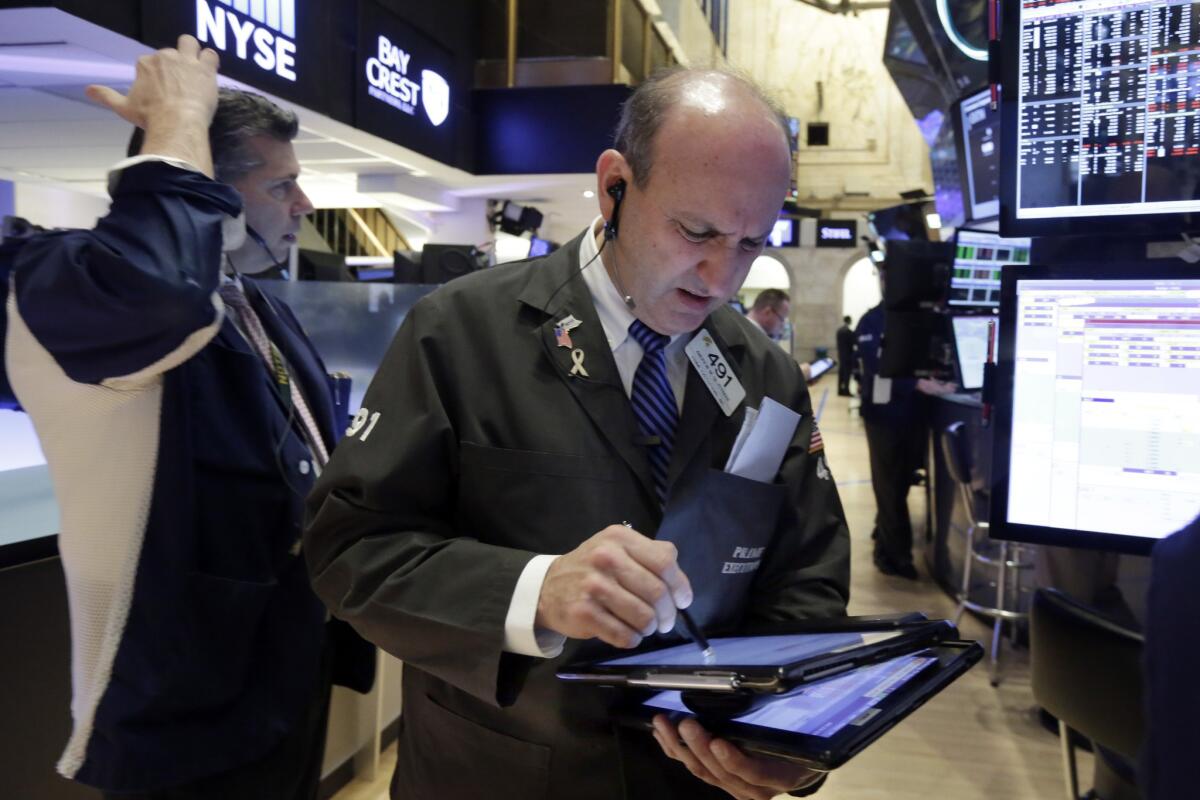Stocks close down sharply, but they were worse earlier: Dow lost 400 at one point

A trader works on the floor of the New York Stock Exchange on Monday.
- Share via
The stock market suffered its second consecutive steep loss Monday in a volatile session that featured a seemingly odd turn of events.
Even as crude oil dropped back below $30 a barrel amid fears of a worldwide economic slowdown, the shares of oil giants Exxon Mobil Corp. and Chevron Corp. jumped in price.
That’s because after weeks of seeing the market fall sharply, many investors are shifting their focus toward shares with stable growth prospects and hefty dividend yields — including the big oil companies — and away from once high-flying stocks, especially those in the tech sector, analysts said.
“There is a shift from go-go momentum growth stocks to old-school stuff,” said David Dietze, chief investment strategist at Point View Wealth Management Inc.
It’s what Wall Street dubs a “rotation” and it means investors are seeking safer investments in the face of the overall market’s decline and volatility.
That volatility was evident again Monday as the market initially plummeted — with the Dow Jones industrial average down 400 points — before a late-afternoon rally pared its losses.
The Dow finished with a loss of 177.92 points, or 1.1%, at 16,027.05. The broader Standard & Poor’s 500 index fell 26.61 points, or 1.4%, to 1,853.44 and the Nasdaq composite index, which is laden with technology shares, dropped 79.39 points, or 1.8%, to 4,283.75.
The losses followed steep declines Friday and added to the substantial damage the market has incurred this year.
The S&P 500 is down 9.3% year to date and the Nasdaq composite index has tumbled 14.5%, well beyond the 10% pullback that’s known as a market “correction.”
One reason: Tech shares were pounded again Monday, especially companies with high price-to-earnings multiples, on grounds that they had become too expensive relative to their growth prospects even if those prospects remain strong.
Fitbit Inc., the maker of activity tracking devices, tumbled 8.6% on Monday and has plunged 51% this year. Amazon.com Inc. and Netflix Inc. are both down about 27% year to date.
Those tech stocks, along with many financial and healthcare stocks, were “the last bastion of the outperforming parts of the market,” said James Paulsen, chief investment strategist at Wells Capital Management Inc.
Major banks and other financial stocks also have taken a beating amid concerns about the banking systems and economies in Europe and Asia, said Art Hogan, chief market strategist at Wunderlich Securities.
Bank of America Corp. has skidded 27% this year, Wells Fargo & Co. is down 14.5% and Visa Inc. has declined 12.6%.
“There is a fear that there may be some sort of a global contagion” that could spread to the U.S. banking system even though “it’s probably not true,” Hogan said.
True or not, the financial stocks “are just catching up with the problems in those [overseas] credit markets,” said Bill King, chief market strategist at M. Ramsey King Securities.
And although many economists don’t see a U.S. recession on the horizon, for those who do fear an economic slowdown “the last thing you want to own is a bank stock,” Paulsen said.
So investors are looking at other market sectors they see as so-called defensive or value plays. Those include the utilities, telecommunication firms and consumer staples companies such as food and beverage firms.
The S&P utilities and telecom indexes are each up 7% this year.
And now Big Oil is starting to move back up, partly due to the companies’ dividends and partly because some investors are betting that even if oil prices drop lower, the companies’ long-term prospects remain solid.
Exxon Mobil, for instance, climbed $1.08 to $81.16 a share Monday, giving the stock a dividend yield of 3.6%. Chevron’s yield is nearly 5%. Both yields are well above the 1% or less available on many savings accounts and the less than 2% yield now available on the 10-year Treasury note.
As stock prices have tumbled, many investors have bought up Treasuries, sending the securities’ prices higher and their yields lower. The yield on the 10-year Treasury, which began the year around 2.2%, fell to 1.75% on Monday.
In the oil market, benchmark light U.S. crude oil fell again Monday, losing $1.20 to $29.69 a barrel on the New York Mercantile Exchange.
Oil prices could fall further and again send energy stocks lower, “but a lot of people are looking at the energy stocks as being the first ones in” when the stock market nosedived “and they will be the first ones out” — or jump in price — when oil markets stabilize, Dietze said.
And for investors looking for other positives, Paulsen said he’s encouraged that “the popular stocks in tech and healthcare, which were leading the market late last summer, are finally capitulating.”
“That’s a good sign that we’re at the latter end of this [decline] rather than at the start,” Paulsen said.
ALSO
Why it took years for the FDA to warn about infections tied to medical scopes
No Chipotle for lunch today: Its U.S. restaurants shut for a food safety meeting
A Bay Area battle over a proposed Warriors move from Oakland to San Francisco
More to Read
Inside the business of entertainment
The Wide Shot brings you news, analysis and insights on everything from streaming wars to production — and what it all means for the future.
You may occasionally receive promotional content from the Los Angeles Times.











